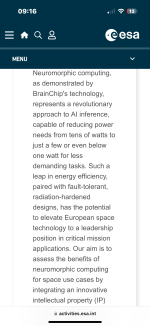Did someone say Cerence?
I just said Cerence.
Note to self: Don't get me started on Cerence!
 Some background info:
Some background info:
BrainChip's Akida technology, as utilized in the Mercedes-Benz Vision EQXX, employs neuromorphic computing to improve the efficiency of voice control systems.
Cerence has been a key provider of voice and AI-driven features in Mercedes-Benz's MBUX system although it wasn't directly incorporated into the Vision EQXX's voice assistant.
Mercedes-Benz has been collaborating with NVIDIA to integrate advanced computing platforms into their vehicles. Currently, Mercedes-Benz utilizes NVIDIA's DRIVE Orin system-on-a-chip (SoC) to power its autonomous systems.
The announcement below describes an expanded partnership between Cerence and NVIDIA and that The "integration involves leveraging Nvidia’s AI Enterprise platform, a comprehensive software solution for cloud-native AI applications, alongside Nvidia DRIVE AGX Orin for specific functionalities of CaLLM Edge. Cerence's CaLLM technology is designed to enhance in-car voice assistants by providing intelligent, natural, and personalized interactions between humans and their vehicles.
It would make sense IMO to integrate Cerence's CaLLM technology with BrainChip's Akida to potentially combine the strengths of both systems; to offer advanced AI-driven voice interactions alongside energy-efficient processing. This could lead to more responsive and efficient in-car voice assistants. Here's hoping this could be on the cards in the near future. Al parties would have to be aware of one another.
Cerence Soars 120% on Expanded Nvidia Partnership
January 3, 2025 Shira Astmann
Cerence Inc. (CRNC) saw its stock price surge by over 120% on Friday following the
announcement of an expanded partnership with Nvidia (NVDA). This collaboration aims to enhance the capabilities of Cerence’s CaLLM™ family of language models, specifically bolstering both its cloud-based
Cerence Automotive Large Language Model (CaLLM) and the
CaLLM Edge, which is an embedded small language model.
The integration involves leveraging Nvidia’s AI Enterprise platform, a comprehensive software solution for cloud-native AI applications, alongside Nvidia DRIVE AGX Orin for specific functionalities of CaLLM Edge. This partnership marks a significant step towards creating more sophisticated in-car AI assistants that can interact seamlessly through both cloud and embedded systems, requiring a blend of hardware, software, and user experience (UX) expertise.
Cerence stated that through close collaboration with Nvidia’s engineers, it has been able to significantly accelerate the development and deployment of its AI technologies. The use of Nvidia’s TensorRT-LLM and NeMo frameworks has been instrumental. TensorRT-LLM optimizes large language models for inference on Nvidia GPUs, while NeMo provides an end-to-end platform for building, customizing, and deploying AI models. This synergy has allowed Cerence to:
– Boost the performance of in-vehicle assistants by utilizing Nvidia’s accelerated computing solutions and system-on-chips (SoCs). The result is a faster, more responsive interaction within vehicles, enhancing the driving experience.
– Develop specialized guardrails for in-car AI using Nvidia NeMo Guardrails. This ensures that Cerence’s AI systems can handle the unique conversational and safety requirements of automotive environments, navigating the complexities of human interaction in a moving vehicle.
– Implement an agentic architecture on the CaLLM Edge using Nvidia DRIVE AGX Orin. This approach not only optimizes performance but also paves the way for future advancements in vehicle user interfaces, offering a more personalized and intuitive interaction model.
This strategic alliance with Nvidia provides Cerence with the tools and infrastructure necessary to support its automotive partners in delivering cutting-edge user experiences. The focus is on creating systems that offer not just performance but also privacy, security, and resilience against malicious interactions, addressing key consumer and manufacturer concerns in the connected car era.
The market’s enthusiastic response to the announcement underscores the potential seen in Cerence’s ability to lead in the automotive AI space, leveraging Nvidia’s technology to push the boundaries of what’s possible in vehicle intelligence. This move positions Cerence to further solidify its role in shaping the future of in-car AI, where the emphasis is increasingly on seamless, secure, and user-friendly technology integration.
Cerence Inc. (CRNC) saw its stock price surge by over 120% on Friday following the announcement of an expanded partnership with Nvidia (NVDA). This collaboration aims to enhance the capabilities of Cerence's CaLLM™ family of language models, specifically bolstering both its cloud-based Cerence...

wallstreetpit.com
speculating about a potential BrainChip presence of some kind in Santa Clara, in the heart of Silicon Valley, where tech giants such as AMD, Intel and NVIDIA are headquartered, but also lots of smaller semiconductor companies and start-ups:







